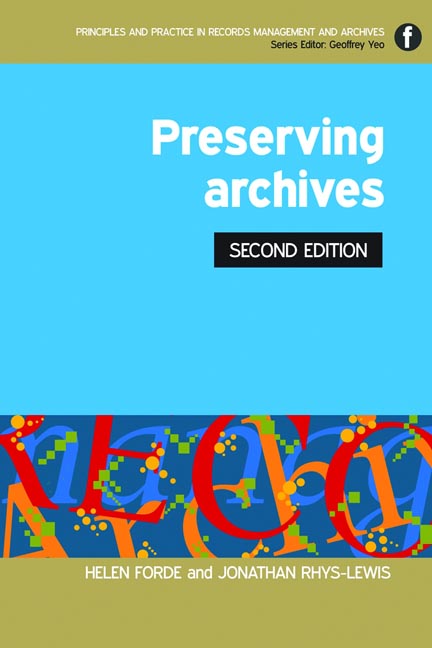Book contents
- Frontmatter
- Contents
- Introduction to the series Geoffrey Yeo
- Preface to the Second Edition
- Acknowledgements
- 1 Introducing archive preservation
- 2 Understanding archival materials and their characteristics
- 3 Managing digital preservation
- 4 Archive buildings and their characteristics
- 5 Safeguarding the building and its contents
- 6 Managing archival storage
- 7 Managing risks and avoiding disaster
- 8 Creating and using surrogates
- 9 Moving the records
- 10 Exhibiting archives
- 11 Handling the records
- 12 Managing a pest control programme
- 13 Training and the use of volunteers
- 14 Putting preservation into practice
- Appendices
- 1 The National Archives Conditions for Loans policy
- 2 A conservation workshop
- 3 Compiling a Preservation Policy; an advisory template
- 4 UCL Library Services: Volunteer Agreement
- 5 Benchmarking entries: MLA
- Bibliography
- British and international standards relating to archive preservation
- Index
2 - A conservation workshop
from Appendices
Published online by Cambridge University Press: 09 June 2018
- Frontmatter
- Contents
- Introduction to the series Geoffrey Yeo
- Preface to the Second Edition
- Acknowledgements
- 1 Introducing archive preservation
- 2 Understanding archival materials and their characteristics
- 3 Managing digital preservation
- 4 Archive buildings and their characteristics
- 5 Safeguarding the building and its contents
- 6 Managing archival storage
- 7 Managing risks and avoiding disaster
- 8 Creating and using surrogates
- 9 Moving the records
- 10 Exhibiting archives
- 11 Handling the records
- 12 Managing a pest control programme
- 13 Training and the use of volunteers
- 14 Putting preservation into practice
- Appendices
- 1 The National Archives Conditions for Loans policy
- 2 A conservation workshop
- 3 Compiling a Preservation Policy; an advisory template
- 4 UCL Library Services: Volunteer Agreement
- 5 Benchmarking entries: MLA
- Bibliography
- British and international standards relating to archive preservation
- Index
Summary
Establishing an in-house conservation workshop is a choice to be made by each archive, weighing up the advantages and disadvantages of outsourcing the work against the capital cost, employment costs and ongoing commitment of an in-house resource. Either way it will be a senior management decision, with the appropriate need for support. Quantifying the need for conservation work, following an appraisal of the general condition of the material (see Chapter 14) is essential before making any decisions.
If the decision is to establish a new workshop in-house an expert will be required to install and manage it. This is likely to be a senior conservator and appointing someone initially with the appropriate accreditation and skills will have major benefits for the project; planning a building programme and a conservation programme will be part of the job specification. Additional staff will be needed but the number will depend on the amount of work to be undertaken and the skills required; resources to meet these needs may only be possible when specified as part of an externally funded project. Conservators will contribute to preservation activities such as monitoring the conditions in the strongrooms and assisting with disaster control and can also run volunteer programmes for basic preservation work such as cleaning and dusting volumes or flattening large documents for protective boxing. Administrative assistance will be needed in large workshops as treatment records (including digital photographs) need to be kept; documents need to be checked in and out of the workshop and materials and equipment ordered and maintained. In smaller workshops, conservation staff will undertake these tasks.
Planning
Planning the installation project is a shared activity between the archivist, the conservator, the architect and the engineer; clearly it must fit within the overall business plan of the archive and adequate time must be allowed to plan the project properly. Visits to other institutions to view any new, or benchmark facilities are vital. Robust specifications, rigorously drawn up, tested and scrutinized are the basis of a successful project. The location of the workshop will depend on whether the facility is to be part of a new build for the whole organization or is to be an adaptation of a part of an existing building.
- Type
- Chapter
- Information
- Preserving Archives , pp. 231 - 236Publisher: FacetPrint publication year: 2013



